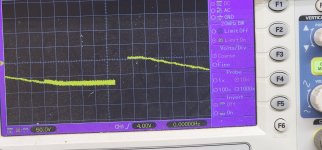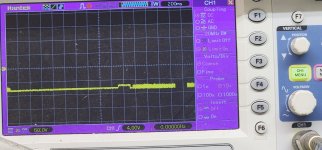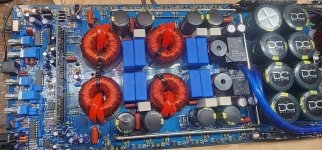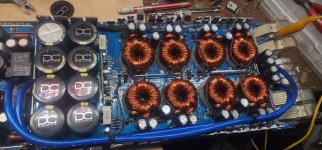I've had I'd with this amp. I had it working, put it in the case and it popped. Now every time I power this thing up at least 1 of the 21844s chips dies. This is with no outputs in. It's a Different one each time. I've blown 5 chips in the last hour. Idk what to do🤬
Is something strange happening with the 12v regulator voltage?
If you disable the ICs, do they survive?
If you disable the ICs, do they survive?
I stepped away yesterday in frustration. Today when I try to power the amp up it draws current as soon at the relay clicks and it goes into protect. The 12v regs seem to be functioning
What starts off cleanly?
With no rail voltage, it can't do much of anything.
Is the behavior you describes completely different from other similar amps? Have you tried testing similar amps under the same conditions and had different results?
Have you tried powering up with reduced rail voltage (will require a bit of extra work)?
With no rail voltage, it can't do much of anything.
Is the behavior you describes completely different from other similar amps? Have you tried testing similar amps under the same conditions and had different results?
Have you tried powering up with reduced rail voltage (will require a bit of extra work)?
The drive wave. Those pictures are the the drive wave on the low side starting up. Notice in the 2nd pic the wave doesn't start smooth. There's that weird spot at the beginning. That blows 1 or more of the drive ic's when that happens if I have fets in if there is rail voltage present when I fire it up. When the rails are completely discharged it fires up without glitching
Do you have a split power supply (±15v) that you could use in place of the rail voltage?
Does this amp have one pair of rectifiers or are the transformers in series?
Photo of amp board?
Does this amp have one pair of rectifiers or are the transformers in series?
Photo of amp board?
Did you confirm that ALL power supplies were functioning normally?
How is this supply configured? Four pairs of series transformers?
I know it may be a lot of work (more for some techs than others) to get the rectifiers out but troubleshooting an amp like this with full rail voltage is going to get expensive.
Have you been replacing all of the driver ICs every time one failed?
I'd recommend that you remove the rectifiers and use the split supply to serve as the rail voltage. Go down to about ±20 if it's adjustable.
If wires make ALL of the connections between the transformers and the rectifiers, you could remove those instead of the rectifiers.
I'd remove all drivers from the driver board.
Confirm that you have 12v regulation to the driver ICs and a switching signal at the input to the driver ICs.
These are only suggestions and I understand if it's too much work but you sometimes have to go to extremes when an amp is destroying parts and you can't find the problem.
How is this supply configured? Four pairs of series transformers?
I know it may be a lot of work (more for some techs than others) to get the rectifiers out but troubleshooting an amp like this with full rail voltage is going to get expensive.
Have you been replacing all of the driver ICs every time one failed?
I'd recommend that you remove the rectifiers and use the split supply to serve as the rail voltage. Go down to about ±20 if it's adjustable.
If wires make ALL of the connections between the transformers and the rectifiers, you could remove those instead of the rectifiers.
I'd remove all drivers from the driver board.
Confirm that you have 12v regulation to the driver ICs and a switching signal at the input to the driver ICs.
These are only suggestions and I understand if it's too much work but you sometimes have to go to extremes when an amp is destroying parts and you can't find the problem.
Yes all of the voltages are there. It's not blowing the ic's unless I have fets it the board. Besides that little glitch the amp works fine. If I load it with fets it powers up fine. I bench tested it with a load for 30 min without issue. As long as I don't power it down and back up again before the rail voltage drops it works perfectly fine. I'm stumped
Are you still operating at full rail voltage?
Is rail voltage developing fully before the output stage starts to oscillate?
Is rail voltage developing fully before the output stage starts to oscillate?
Yes full rail voltage.
It starts oscillating on the way down. U can see in the first of the 2 photos I posted when in starts.
It starts oscillating on the way down. U can see in the first of the 2 photos I posted when in starts.
I still don't understand those photos.
Does it have a Q51. A 2SA1381? If so, pull it and check it very carefully for leakage (in ohms and diode-check modes) and open junctions as well as shorted junctions.
Does it have a Q51. A 2SA1381? If so, pull it and check it very carefully for leakage (in ohms and diode-check modes) and open junctions as well as shorted junctions.
Where the trace gets thick is the oscillation starting. It's slowed down to catch the glitch. In this pic the red is oscillation. Then i shut down the amp and restarted it. The blue is the glitch before the oscillation starts again.
If the amp tries to oscillate before all supply voltages are at full voltage (rail, regulated 12v...), the ICs will not function correctly and will commonly break things (outputs which results in ICs failing).
You need to make sure that the enable signal to the driver IC is always delayed enough to allow all voltages to develop.
Do you have a C82 next to Q51? If so, is it within tolerance?
Do you have a C82 next to Q51? If so, is it within tolerance?
- Home
- General Interest
- Car Audio
- DC Audio 5k




